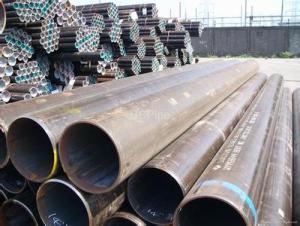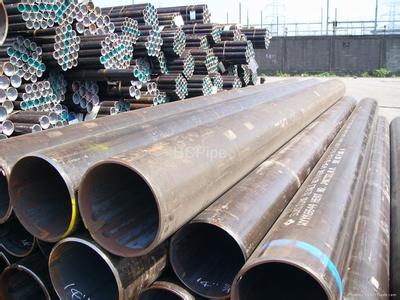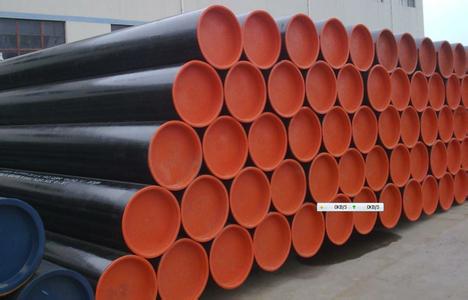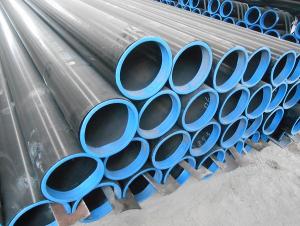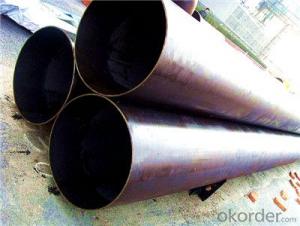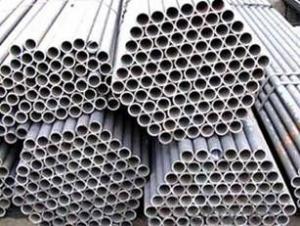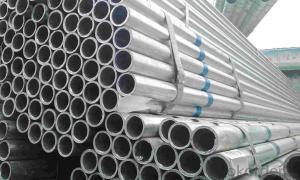High grade seamless steel tube
- Loading Port:
- China Main Port
- Payment Terms:
- TT OR LC
- Min Order Qty:
- -
- Supply Capability:
- -
OKorder Service Pledge
OKorder Financial Service
You Might Also Like
Seamless pipe is a hollow section, no surrounding joint strip steel. The worldproduction of seamless pipe, a total of more than 5100 production plant more than 1850 companies in more than 110 countries under the production of oilpipe, which has more than 260 factory more than 170 companies in 44 countries under the.
Seamless tube with 1 structure (GB/T8162-2008) is used for seamless tubegeneral structure and mechanical structure.
Seamless pipe 2 fluid transport (GB/T8163-2008) is used for general seamless pipe conveying water, oil, gas and other fluid.
For low and medium pressure boiler seamless pipe 3 (GB3087-2008) is used in the manufacture of various structure of low and medium pressure boilersuperheated steam pipe, superheated steam pipe, boiling water pipe andlocomotive boiler flue tube, small pipe and brick arch tubes of high-quality carbon structural steel hot-rolled and cold drawn seamless pipe (rolling).
High pressure boiler seamless pipe with 4 (GB5310-2008) is used for heating surface tube boiler manufacturing high and higher pressure of high quality carbon steel, alloy steel and heat resisting stainless steel seamless pipe.
High pressure seamless tube with 5 chemical fertilizer equipment (GB6479-2000) is suitable for the work temperature of high quality carbon structural steel and alloy steel seamless tube of -40~400 DEG C, the working pressurefor chemical equipment and pipeline of 10~30Ma.
Seamless tube with 6 petroleum cracking (GB9948-2006) is applied to the oil refinery furnace tubes, heat exchangers and pipe seamless pipe.
Steel pipe 7 geological drilling (YB235-70) is for the Geological Department of the steel core drilling is used, according to use can be divided into the drill pipe, drill collar, core pipe, casing and sedimentation tubes.
Seamless tube with 8 diamond core drilling (GB3423-82) is used for seamlessdrill pipe, casing, Yan Xingan diamond core drilling.
9 oil drilling pipe (YB528-65) is used for seamless oil drilling internal upset ends or the outer thickening.
Seamless tube
Seamless tube
10 ships for carbon steel seamless pipe (GB5312-85)
China classification society rules for materials and welding -- ChineseClassification Society (CCS)
The Norway Classification Society (DNV) specification -- Norway Classification Society (DNV)
Lloyd's register of shipping (LR) specification -- British Lloyd's register of shipping (LR)
Germanischer Lloyd (GL) specification -- Germanischer Lloyd (GL)
American Bureau of shipping (ABS) specification - American Bureau of shipping (ABS)
Bureau Veritas (BV) specification - French Classification Society (BV)
The Italy Classification Society (RINA) specification, Italy Classification Society(RINA)
The Japanese classification society (NK) specification -- the Japaneseclassification society (NK)
The ship is making I level pressure piping, II level pressure piping, boiler and superheater for carbon steel seamless pipe. Carbon steel seamless pipe walltemperature does not exceed 450 degrees, alloy steel seamless pipe walltemperature more than 450 DEG C.
11 of automobile half shaft sleeve pipe seamless pipe (GB3088-82) is the manufacture of automobile half shaft sleeve and the driving bridge shell axis effective quality carbon structural steel and alloy structural steel hot-rolled seamless tube.
High pressure oil pipe with 12 diesel engine (GB3093-86) is a cold drawn seamless pipe manufacturing high-pressure diesel injection systems for.
With precision internal diameter seamless pipe 13 for hydraulic and pneumatic cylinder (GB8713-88) is the manufacture of hydraulic and pneumatic cylinderwith precision diameter with cold drawn or cold rolled precision seamless tube.
14 cold drawn or cold rolled precision seamless pipe (GB3639-83) is used fordimensional precision mechanical structure, hydraulic equipment, high and good surface finish of cold drawn or cold rolled precision seamless tube.Selection of precision seamless tube manufacturing mechanical or hydraulic equipment.
Stainless steel seamless tube with 15 structure (GB/T14975-2002) is widely used in chemical, petroleum, made of stainless steel hot-rolled textile, medical,food, machinery and other industrial anti-corrosion pipes and structural partsand components of a (extrusion, expansion) and cold drawing (rolling)seamless pipe.
Stainless steel seamless tube 16 fluid transport (GB/T14976-2002) is used for the transmission fluid made of stainless steel hot-rolled (extrusion, expansion)and cold drawing (rolling) seamless pipe.
17 special seamless tube is in addition to general seamless other cross section shapes of circular pipe outside the. According to the section of the steel pipe of different shapes and sizes can be divided into equal wall thickness of seamless pipe (codenamed D), unequal wall thickness of seamless pipe (codenamed BD), variable diameter special-shaped seamlesspipe (codenamed BJ). Shaped seamless pipe is widely used for variousstructural parts, tools and machinery parts.
Seamless steel tubes for 18 cryogenic pipe (GB/T18984-2003) is the use ofseamless steel tube for -45 to -195 DEG C low-temperature pressure vessellevel and low temperature heat exchanger tubes
General seamless tube is made with 10, 20, 30, 35 and 45 carbon steel 16Mnand 5MnV low alloy structural steel or 40Cr, 30CrMnSi, 45Mn2, 40MnB and other alloy steel hot-rolled or cold-rolled made. 10 and 20 low carbon steelseamless pipe is mainly used for fluid conveying pipeline. In 45, 40Cr in carbon steel seamless pipe used to make machine parts, such as automobile, tractorparts under stress. General seamless pipe to ensure the strength andflattening test. Hot rolled steel pipe in hot state or heat treatment delivery; cold with heat to heat treatment delivery. Seamless steel tubes for low and medium pressure boiler: used in the manufacture of a variety of low and medium pressure boiler, the superheated steam tube, boiling water pipe, superheated steam pipe, water wall tube and locomotive boiler flue tube, pipe and pipe arch bricks.
With high-quality carbon structural steel hot-rolled or cold-rolled seamless pipe(dial). Mainly used in 10, 20 steel manufacturing, in addition to ensure that the chemical composition and mechanical properties of the outer do pressure test,curling, flaring, flattening test. Hot rolled in hot state delivery, Leng Zha(allocated) to heat treatment delivery.
- Q: How do you determine the maximum allowable stress for a steel pipe?
- To determine the maximum allowable stress for a steel pipe, several factors need to be considered. These include the material properties of the steel, such as its yield strength, ultimate tensile strength, and elongation. Additionally, the pipe's dimensions, wall thickness, and the intended application or service conditions must be taken into account. By considering these factors, along with relevant design codes and standards, engineers can calculate the maximum stress that the steel pipe can safely withstand without experiencing failure.
- Q: Are steel pipes suitable for structural applications?
- Indeed, steel pipes prove to be appropriate for structural applications. Renowned for their strength, durability, and versatility, steel pipes emerge as an ideal choice for diverse structural purposes. They can be utilized in constructions, bridges, stadiums, and other edifices to provide essential support and stability. Steel pipes exhibit remarkable tensile strength, enabling them to withstand substantial burdens and resist deformation when subjected to pressure. Moreover, their resistance to corrosion renders them dependable for structural applications, even in severe environments. The utilization of steel pipes in structural applications is further amplified by their cost-effectiveness and ease of installation. In summary, owing to their strength, durability, versatility, and cost-effectiveness, steel pipes remain a favored option within the construction industry.
- Q: Are steel pipes suitable for underground gas distribution?
- Steel pipes are indeed appropriate for the distribution of gas underground. Due to their remarkable strength, durability, and resistance to corrosion, steel pipes are extensively employed in gas distribution systems. The ability of steel pipes to endure the pressure and stress in underground environments renders them a dependable choice for gas transportation. Moreover, steel pipes possess the added benefit of being capable of withstanding high temperatures and resisting fire, making them a secure alternative for underground gas distribution. Nonetheless, it is crucial to ensure that the steel pipes employed are adequately coated and shielded against corrosion to guarantee their longevity and avert any possible leaks or harm.
- Q: How are steel pipes protected against abrasive wear?
- Steel pipes are protected against abrasive wear through various methods such as lining the interior of the pipes with abrasion-resistant materials, applying protective coatings on the pipe surface, or using ceramic tiles or liners. These measures help minimize the effects of friction and abrasion, ensuring the longevity and durability of the steel pipes.
- Q: Can steel pipes be used for fencing or railing?
- Yes, steel pipes can be used for fencing or railing. Steel pipes are durable, strong, and resistant to weather conditions, making them a suitable choice for fencing or railing applications. They provide stability and security while also offering an aesthetically pleasing appearance. Additionally, steel pipes can be easily customized and installed, making them a popular choice for fencing and railing projects.
- Q: Can steel pipes be used for culvert applications?
- Yes, steel pipes can be used for culvert applications. Steel pipes are commonly used for culverts due to their durability, strength, and resistance to corrosion. They can withstand heavy loads and are able to handle high traffic volumes and large water flows. Additionally, steel pipes can be easily manufactured in various sizes and shapes to suit specific culvert requirements. Their longevity and low maintenance needs make them a cost-effective choice for culvert applications.
- Q: Can steel pipes be used for underground fuel storage systems?
- Yes, steel pipes can be used for underground fuel storage systems. Steel pipes are commonly used for underground fuel storage due to their durability, strength, and resistance to corrosion. Additionally, steel pipes can be easily welded and sealed, ensuring a secure storage system for fuels.
- Q: What are the applications of steel pipes?
- Steel pipes have a wide range of applications in various industries due to their durability, strength, and versatility. Some of the common applications of steel pipes include: 1. Plumbing and water distribution: Steel pipes are commonly used in plumbing systems to transport water and other fluids. They are resistant to corrosion and can withstand high pressure, making them ideal for water distribution networks in residential, commercial, and industrial buildings. 2. Oil and gas industry: Steel pipes are extensively used in the oil and gas industry for the transportation of oil, natural gas, and other petroleum products. They are able to handle high-pressure and high-temperature environments, making them crucial in drilling, production, and refining processes. 3. Construction and infrastructure: Steel pipes are widely employed in construction projects for various purposes such as structural support, foundations, scaffolding, and underground piping systems. They provide a strong and reliable framework for buildings, bridges, tunnels, and highways. 4. Industrial applications: Steel pipes are used in various industrial applications such as manufacturing, power plants, chemical processing, and food processing. They are often used to transport liquids, gases, or slurries within the production processes or to transfer heat in heat exchangers and condensers. 5. Agricultural sector: Steel pipes are commonly used in the agricultural sector for irrigation systems, particularly in large-scale farming. They are used to transport water from a water source to the fields, ensuring efficient and controlled water distribution. 6. Mining industry: Steel pipes are utilized in the mining industry for the extraction and transportation of minerals, ores, and other mining materials. They are resistant to abrasion and corrosion, making them suitable for the harsh and demanding conditions of mining operations. 7. Mechanical and automotive applications: Steel pipes find application in the manufacturing of various mechanical components, such as automotive exhaust systems, hydraulic cylinders, and precision tubing. They offer high strength, dimensional stability, and resistance to impact and vibration. 8. Infrastructure and utilities: Steel pipes are commonly used in infrastructure projects for the transportation of sewage, stormwater, and wastewater. They are durable, resistant to chemical corrosion, and can withstand underground conditions, making them suitable for sewer and drainage systems. In summary, the applications of steel pipes are vast and diverse, ranging from plumbing and water distribution to oil and gas industry, construction, agriculture, mining, mechanical and automotive sectors, and infrastructure projects. Their robustness, versatility, and ability to withstand extreme conditions make them a fundamental component in numerous industries.
- Q: How are steel pipes used in HVAC systems?
- Steel pipes are used in HVAC systems for various purposes such as transporting hot or cold water, steam, or refrigerant throughout the system. They are commonly used for supply and return lines, as well as for connecting various HVAC components like chillers, boilers, air handlers, and heat exchangers. Steel pipes are preferred in HVAC systems due to their durability, strength, and resistance to corrosion and high pressure.
- Q: What is the difference between seamless steel pipes and seamless alloy steel pipes?
- The main difference between seamless steel pipes and seamless alloy steel pipes lies in their composition. Seamless steel pipes are made from carbon steel, which is primarily composed of iron and carbon. On the other hand, seamless alloy steel pipes are made from a combination of carbon steel and various alloying elements such as chromium, nickel, or molybdenum. These alloying elements enhance the properties of the steel, making it more resistant to corrosion, heat, and pressure. They also provide improved strength and durability, making alloy steel pipes suitable for applications that require high performance and reliability. In summary, while both seamless steel pipes and seamless alloy steel pipes are used for various industrial applications, alloy steel pipes offer superior performance due to their alloying elements, making them more suitable for demanding conditions.
Send your message to us
High grade seamless steel tube
- Loading Port:
- China Main Port
- Payment Terms:
- TT OR LC
- Min Order Qty:
- -
- Supply Capability:
- -
OKorder Service Pledge
OKorder Financial Service
Similar products
Hot products
Hot Searches
Related keywords
